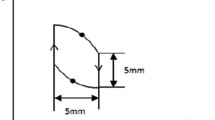Abstract
The study presents the effect of Wire Electro Discharge Machining (WEDM) system parameters on the Material Removal Rate (MRR), surface roughness and surface morphology of Ti 50Ni 45Cu 5 SMA developed using vacuum arc melting. The WEDM parameters such as pulse on time, peak current, pulse off time and table feed were selected as control factors over MRR and surface roughness. The results reveal that the surface roughness and MRR increases with increased peak current, pulse on time and table feed but decreases slightly with pulse off time. Higher MRR was attained at 5Amps peak current and 70 μm/s table feed. Better surface roughness was obtained for a combination of lower pulse on time, peak current and table feed with high pulse off time. Surface defects such as recast layer, craters, micro–cracks, pockmarks and voids were found on the machined surface. The globule of appendages formed around the craters and the intensity of the crater was evident for the higher surface roughness with an increase in peak current and pulse-on time during WEDM.
Similar content being viewed by others
References
Elahinia MH, Hashemi M, Tabesh M, Bhaduri SB (2011) Manufacturing and processing of NiTi implants: a review. Prog Mater Sci 57:911–946
Chang-Jun Q, Pei-Sun M, Qin Y (2004) A prototype micro-wheeled-robot using SMA actuator. Sensors Actuators A Phys 113:94–99
Lin HC, Lin KM, Chen YC A study on the machining characteristics of TiNi shape memory alloys. J Mater Process Technol 200; 105:327–332
Nespoli A, Passaretti F, Villa E (2013) Phase transition and mechanical damping properties: A DMTA study of NiTiCu shape memory alloys. Intermetallics 32:394–400
Kang S-w, Lee Y-h, Lim Y-m, Nam J-m, Nama T-h, Kim Y-w (2008) Relationship between grain size and martensitic transformation start temperature in a Ti–30Ni–20Cu alloy ribbon. Scr Mater 59:1186–1189
Mercier O, Melton KN (1979) The substitution of Cu for Ni in NiTi shape memory alloys. Metall Trans A Am Soc Metals Metall Soc AIME 10:387–389
Tsuji K, Nomura K (1992) Effects of Ni-Ti-Cu alloy composition and heat treatment temperature after cold working on phase transformation characteristics. J Mater Sci 2:2199–2204
Kim YW, Nam TH (2004) The effect of the melt spinning processing parameters on the martensitic transformation in Ti50–Ni35–Cu15 shape memory alloys. Scripta Mater 51:653–657
Kim Y-w, Choi K-c, Chung Y-s, Choi E, Nam T-h (2013) Microstructure and martensitic transformation characteristics of Gas-atomized Ti–Ni–Cu powders. J Alloys Compd 577:S227–S231
Wu SK, Lin HC, Chen CC (1999) A study on the machinability of a Ti 49.6Ni 50.4 shape memory alloy. Mater Lett 40:27–32
Biermann D, Kahleyss F, Surmann T (2009) ∖Micromilling of NiTi shape-memory alloys with ball nose cutters. Mater Manuf Process 24:1266–1273
Manjaiah M, Narendranath S, Basavarajappa S (2014) Review on non-conventional machining of shape memory alloys. 24 1:12–21
Ho KH, Newman ST, Rahimifard S, Allen RD (2004) State of the art in wire electrical discharge machining (WEDM). Int J Mach Tools Manuf 44:1247–1259
Chen SL, Hsieh S, Lin H, Lin M, Huang J (2007) Electrical discharge machining of TiNiCr and TiNiZr ternary shape memory alloys. Mater Sci Eng A 446:486–492
Chen SL, Hsieh SF, Lin HC, Lin MH, Huang JS (2008) Electrical discharge machining of a NiAlFe ternary shape memory alloy. J Alloys Compd 464:446–451
Hsieh SF, Chen SL, Lin HC, Lin MH, Chiou SY (2009) The machining characteristics and shape recovery ability of Ti–Ni–X (X =Zr, Cr) ternary shape memory alloys using the wire electro-discharge machining. Int J Mach Tools Manuf 49:509–514
Kao JY, Tsao CC, Wang SS, Hsu CY (2010) Optimization of the EDM parameters on machining Ti – 6Al – 4V with multiple quality characteristics. Int J Adv Manuf Technol 47:395–402
Laio YS, Hung JT, Su HC (1997) A study on the machining parameters optimization of wire electrical discharge machining. J Mater Process Technol 136:487–493
Newton TR, Melkote SN, Watkins TR, Trejo RM, Reister L (2009) Investigation of the effect of process parameters on the formation and characteristics of recast layer in wire-EDM of Inconel. Mater Sci Eng A 718(514):208–215
Tarng YS, Chung LK (1995) Determination of optimal cutting parameters in wire electrical discharge machining. Int J Mach Tools Manuf 35(12):1693–1701
Author information
Authors and Affiliations
Corresponding author
Rights and permissions
About this article
Cite this article
Manjaiah, M., Narendranath, S. & Basavarajappa, S. Wire Electro Discharge Machining Performance of TiNiCu Shape Memory Alloy. Silicon 8, 467–475 (2016). https://doi.org/10.1007/s12633-014-9273-4
Received:
Accepted:
Published:
Issue Date:
DOI: https://doi.org/10.1007/s12633-014-9273-4



